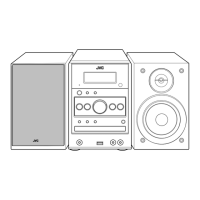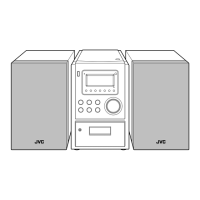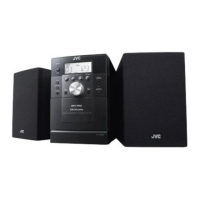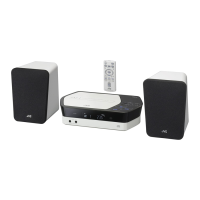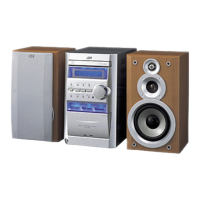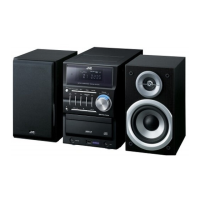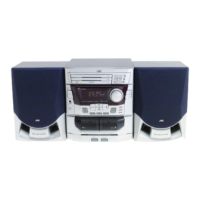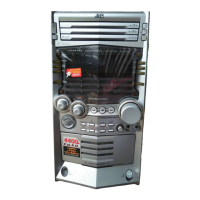Do you have a question about the JVC Compact Component System CA-DXJ20 and is the answer not in the manual?
| Type | Compact Component System |
|---|---|
| Brand | JVC |
| Model | CA-DXJ20 |
| CD Player | Yes |
| Tuner | FM/AM |
| Speaker Configuration | 2.0 |
| Output Power (per channel) | 50 W |
| Speakers | Included |
| Remote Control | Yes |
| Functions | Radio |
| CD Player Type | Single Disc |
| Connectivity | Headphone Jack |
Explains the operation of the power button and standby mode indicator.
General safety warnings regarding electrical shock and fire hazards.
Cautionary notes about not blocking ventilation openings to prevent overheating.
Warning about potential hearing damage from excessive headphone volume.
Details on Class 1 laser apparatus, safety warnings, and label information.
Diagram illustrating ventilation requirements from the front.
Diagram illustrating ventilation requirements from the side.
Instructions for proper disposal of electrical and electronic equipment in the EU.
Information for corporate users on how to dispose of the product.
Guidelines for disposing of the product in countries outside the EU.
Lists the types of discs and files that can be played back by the system.
Details on the supported color systems (NTSC/PAL) and their implications.
Explanation of region code limitations for DVD-video playback.
Lists the digital audio formats supported by the system.
Guidance on how to navigate and utilize the information within the manual.
Instructions for proper installation, including placement and ventilation.
Advice on handling power cords and avoiding electrical hazards.
Information on preventing moisture condensation inside the unit.
Precautions to prevent overheating, including fan operation.
Covers handling foreign objects, disassembly warnings, and general advice.
Lists all the items included in the product package.
Instructions for connecting the system to a TV or monitor via video output.
Guide for connecting digital audio components to the system.
Instructions for connecting the AM and FM antennas.
Specific connection details for subwoofers on the CA-DXJ30 model.
Instructions for connecting the main speakers to the system.
Guide for connecting external devices via analog audio input.
Final step detailing how to connect the system to a power source.
Specifics on connecting video cables to the TV/monitor.
Details for connecting digital audio sources.
Comprehensive guide for connecting antennas and improving reception.
Step-by-step instructions for assembling the AM loop antenna.
Further instructions and considerations for connecting antennas.
Tips and methods to enhance FM radio signal quality.
General instructions for connecting speakers, including polarity.
Specific wiring diagrams for connecting speakers to the CA-DXJ30 model.
Specific wiring diagrams for connecting speakers to the CA-DXJ20 model.
Specific wiring diagrams for connecting speakers to the CA-DXJ10 model.
Instructions for connecting external devices via the AUX input.
Reminder to connect the power cord only after all other connections are made.
Steps to prepare the remote control for system operation.
Step to enter the color system setup mode.
Choosing the appropriate video system and scan mode.
Final step to save the selected color system and scan mode.
Explains indicators for signal sources, karaoke, 3D Phonic, disc, FM, repeat, and playback modes.
Details indicators related to cassette deck operations and timer functions.
Covers indicators for PG/PL, Sound Modes, Progressive Scan, B.S.P., Bonus, and USB.
Covers powering on, selecting input source, and adjusting volume.
Instructions on how to put the system into standby mode.
Guide on how to listen to audio privately using headphones.
Explanation of how to use the numeric buttons for selection.
Step one for programming: tuning into a desired radio station.
Step two for programming: entering the mode to assign station numbers.
Step three for programming: choosing a memory slot for the station.
Step four for programming: saving the tuned station.
How to switch between FM and AM tuning bands.
Instructions for recalling and listening to saved radio stations.
Covers starting, pausing, stopping, and resuming playback.
Explains the meaning of various symbols displayed during playback.
Guidance on how to properly insert discs into the player.
Instructions for connecting USB storage devices for media playback.
Methods for navigating and selecting content like episodes, groups, or tracks.
How to locate and jump to specific points within a disc.
Step to access the interactive menu of a disc.
How to navigate and choose options within the disc menu.
Explanation of the Playback Control (PBC) function for specific disc types.
Instructions for fast winding audio cassettes forward or backward.
How to change the tape direction on Deck B.
Details on the automatic tape direction switching feature.
Guidance on correctly inserting an audio cassette into the deck.
How to adjust the audio balance between the left and right speakers.
Adjusting the level of low frequencies for enhanced bass response.
Using VARIO BASS to optimize low frequencies based on the audio source.
Automatic selection of VARIO BASS mode based on the source.
VARIO BASS mode suitable for music and a comfortable low-frequency level.
VARIO BASS mode optimized for video sources and high low-frequency levels.
VARIO BASS mode for disco/techno music, providing strong low-frequency effects.
VARIO BASS mode for various music styles, offering balanced low frequencies.
Details on preset sound modes like ROCK, POP, CLASSIC, DANCE, HALL, STADIUM.
Explanation of spatial sound modes that enhance the sense of space.
Information on creating and saving personalized sound settings.
Specifics on the three user-customizable sound modes.
Adjusting image parameters like Gamma, Brightness, Contrast, Saturation, Color, Sharpness.
Step-by-step instructions for fine-tuning picture settings.
Guide on how to set the system's internal clock.
First step to access the clock setting function.
Second step to set the clock time accurately.
How to customize the information displayed on the system screen.
How to choose different audio tracks or channels for playback.
How to select the desired subtitle language for display.
How to switch between different camera angles during playback.
Using the 'Glance Back' feature for instant replay.
How to select and view still images from discs.
Instructions for accessing exclusive bonus content on DVD-audio discs.
How to temporarily pause the playback of images.
Detailed instructions for advancing playback one frame at a time.
Activating the Program Play function for custom playback sequences.
Choosing tracks, files, or sections to include in the playback program.
Finalizing the sequence of items for programmed playback.
Initiating playback according to the programmed sequence.
Basic playback controls like skipping tracks and pausing.
How to review the current programmed playback sequence.
Steps to delete or add items to the programmed playback list.
How to disable the Program Play function.
Activating the mode to play content in a random order.
Initiating playback in random order.
Repeat modes applicable to discs, audio files, and USB storage.
Setting the starting point for the A-B repeat segment.
Setting the ending point for the A-B repeat segment.
Information displayed on the screen panel for DVD-Video playback.
Information displayed for DVD-Audio playback on CA-DXJ30.
Information displayed on the screen panel for DVD-VR playback.
Information displayed on the screen panel for SVCD playback.
Information displayed on the screen panel for VCD playback.
Information displayed on the screen panel for CD playback.
Information displayed for video files on disc.
Information displayed for video files on USB storage.
First step to display the on-screen panel and its menu.
Second step to highlight and select an item on the screen.
Third step to show a pop-up window for further options.
Fourth step to choose an option from the pop-up window.
Fifth step to finalize the on-screen operation.
How to change the time display format during playback.
Choosing the desired repeat playback mode.
Using the on-screen display to configure repeat playback.
Activating the A-B repeat function for specific segments.
Defining the starting point for the A-B repeat segment.
Defining the ending point for the A-B repeat segment.
Starting the process to search for a specific time point on a disc.
Inputting the target time for the search.
Finalizing the time search operation.
Starting the process to search for a specific section or track.
Inputting the target section or track number.
Finalizing the section or track search operation.
Specific controls for managing playback on DVD-VR discs via screen.
Choosing the method for playback control on DVD-VR discs.
Displays the current input source, such as DVD/CD or USB.
Provides details on file structure, groups, and playback modes.
Information on RANDOM/PROGRAM modes and repeat playback settings.
Instructions on navigating the highlight bar within lists.
How to select items from the displayed lists.
Procedure to start playback of JPEG image files.
Procedure to start playback of other supported file types.
Repeat playback options for original programs on DVD-VR discs.
Repeat playback options for playback lists on DVD-VR discs.
Step one: inserting a cassette into Deck B for recording.
Verifying tape direction and reverse mode settings on the display.
Instructions for changing the tape direction manually.
Starting playback of the audio source for recording.
Initiating the recording process.
Ending the recording process.
Choosing the source tape for copying.
Loading the source and blank cassettes for copying.
Verifying tape direction before starting the copying process.
Initiating the audio cassette copying process.
Initial step for setting up synchronized recording from disc/USB.
Key information and warnings before using karaoke features.
Initial setup step: setting the microphone level to zero.
Connecting microphones to the system's MIC 1 and MIC 2 jacks.
Starting playback of the audio source for karaoke.
Instructions for singing into the connected microphone.
Fine-tuning microphone sensitivity and overall volume levels.
How to disable the automatic microphone mixing feature.
Adjusting vocal levels and selecting audio channels for karaoke.
Specifics on how the system scores karaoke performances with DVD-Video.
Specifics on how the system scores karaoke performances with SVCD/CD.
Steps to follow after selecting the audio track for scoring.
Choosing the audio source for karaoke scoring.
Connecting microphones for the scoring function.
How to adjust the echo effect applied to the microphone input.
Adjusting the pitch (tone) of the microphone signal.
Modifying the sensitivity or level for the karaoke scoring function.
Enabling or disabling the fanfare sound effect for karaoke.
Arranging songs or tracks in a specific playback sequence.
The maximum number of items that can be programmed into a sequence.
Limitation regarding the use of USB storage devices for this function.
How to display the list of programmed karaoke songs.
Steps to edit or remove items from the karaoke program.
Instructions for adding more songs or items to the program.
Step-by-step guide for setting up recording and daily timers.
Accessing and adjusting language settings for menus and audio.
Adjusting display settings like monitor type and aspect ratio.
Accessing the on-screen guide and other miscellaneous settings.
Proper procedures for handling and caring for discs.
Instructions on how to clean discs to ensure optimal playback.
Guidelines for handling audio cassettes and protecting recordings.
Instructions for cleaning the main unit and its components.
Choosing between the daily timer and recording timer functions.
Steps for configuring the time, source, and other parameters for timers.
Explanation of the recording timer's operation and functionality.
Explanation of the daily timer's operation and functionality.
Procedure to turn off a timer once its settings are complete.
Configuring the duration before the system automatically shuts down.
How to check the remaining time before automatic power off.
Understanding the priority order when multiple timers are active.
General steps for accessing and changing system settings via menus.
First step to access the setup menu by pressing the SET UP button.
Using navigation buttons to browse through menu options.
Choosing a specific menu item to adjust.
Finalizing the selection of a menu item.
Choosing a parameter value and confirming the change.
Controlling the TV's power and selecting the input signal source.
Using the remote to adjust the TV's volume.
Using the remote to change TV channels.
Further details on selecting color systems and scan modes.
Notes specific to the CA-DXJ30 model regarding video input.
References to other sections detailing playback functions.
Important considerations for radio playback, such as station memory.
Important considerations for playing discs and USB devices.
Requirements for USB cables and system compatibility.
Lists the supported file formats for audio, video, and images.
Details and requirements for playing MP3, WMA, and WAV files from discs.
Details and requirements for playing DVD-VR discs.
Basic steps to resolve common issues like function errors or no sound.
Troubleshooting problems related to radio reception and media playback.
Resolving issues with disc trays, cassette decks, and file display.
Troubleshooting problems with karaoke scoring, timers, and recording.
Problems related to bass settings like Active Bass and VARIO BASS.
Troubleshooting custom sound modes, 3D Phonic, and clock settings.
Issues with time settings, playback operations, and region codes.
Problems with audio track selection and karaoke program management.
Proper procedures for handling, cleaning, and caring for discs.
Guidelines for handling audio cassettes and protecting recorded content.
Instructions for cleaning the exterior and interior of the system unit.
Detailed technical specifications for the amplifier section.
Specifications for speaker output power and impedance.
Specifications for digital output and analog audio inputs.
Specifications for video output formats and color systems.
Details on the types of connectors used for acoustic systems.
Technical specifications for the FM and AM tuner sections.
Technical specifications for the disc and file playback unit.
Lists the types of discs and files supported by the player.
Technical specifications for the cassette deck mechanism.
Overall system specifications including dimensions and weight.
Detailed specifications for the SP-DXJ10 acoustic system.
Specifications related to USB memory device compatibility.
List of items included with the product.

